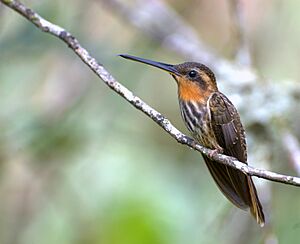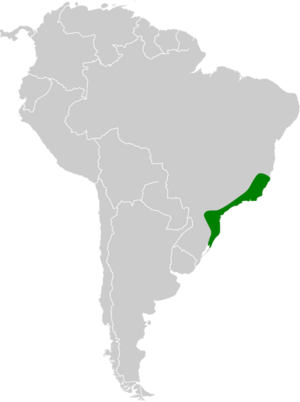Saw-billed hermit facts for kids
Quick facts for kids Saw-billed hermit |
|
|---|---|
 |
|
| Conservation status | |
| Scientific classification | |
| Genus: |
Ramphodon
|
| Species: |
naevius
|
 |
|
| Synonyms | |
|
Trochilus naevius Dumont, 1818 |
|
The saw-billed hermit (Ramphodon naevius) is a special type of hummingbird. It belongs to the Trochilidae family. This unique bird lives only in Brazil, meaning it is endemic there.
Contents
About the Saw-billed Hermit
The saw-billed hermit is part of the hermit hummingbird group. However, it is the most similar to other typical hummingbirds. It is the only species in its group, called a genus, and does not have any different types or subspecies.
What Does It Look Like?
The saw-billed hermit is about 14 to 16 centimeters (5.5 to 6.3 inches) long. It weighs between 5.3 and 9 grams (0.19 to 0.32 ounces). Male birds are usually heavier than females.
Both male and female saw-billed hermits have a unique bill. It has saw-like teeth along the edges. The male's bill also has a hooked tip. Only one other hummingbird, the tooth-billed hummingbird, has a bill like this.
Their upper body is covered in scaly brown feathers. Their underside has dark and light stripes. They have a reddish-orange throat and a dark patch through their eye. A white stripe goes above their eye. The top of their tail is purplish-black. The underside of the tail has more buff color towards the ends of the outer feathers.
Where Does It Live?
The saw-billed hermit lives in a small area of southeastern Brazil. You can find it from the states of Minas Gerais and Espírito Santo down to eastern Santa Catarina. It also lives in the northern part of Rio Grande do Sul.
This bird makes its home in the lower parts of the humid coastal Atlantic Forest. It lives at elevations up to about 500 meters (1,640 feet) above sea level.
How It Behaves
Movement and Travel
Scientists believe the saw-billed hermit usually stays in one place. However, some think it might make short trips sometimes.
What It Eats
The saw-billed hermit drinks nectar from many different kinds of flowers. These flowers are usually tube-shaped. It mostly feeds close to the ground, within about 6 meters (20 feet). But it has been seen feeding as high as 15 meters (49 feet).
Like other hermit hummingbirds, it is a "trap-line" feeder. This means it flies a regular path, visiting a circuit of flowering plants. Unlike many other trap-liners, it protects its feeding route. It will act aggressively towards other saw-billed hermits and other hummingbirds. Besides nectar, it also eats small arthropods (like insects or spiders) that it picks from plants.
Reproduction and Nests
The saw-billed hermit's breeding season is not fully known. It seems to happen from July to September. It builds a cone-shaped nest using plant materials and spiderwebs. The nest is usually found under the tip of a long, hanging leaf. A female typically lays two eggs.
Its Calls and Songs
The saw-billed hermit's song is described as a "very high, chattering twitter." Its calls include a fast series of high "bic" notes. It also makes a descending series of "seee" notes. These calls are often used when the bird is defending its feeding route.
Conservation Status
The IUCN (International Union for Conservation of Nature) has listed the saw-billed hermit as a species of "Least Concern." This means it is not currently in danger of disappearing. However, its population is thought to be decreasing. This is mainly because its natural home is being lost.
Images for kids



